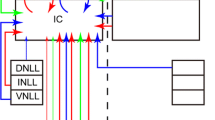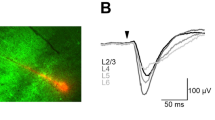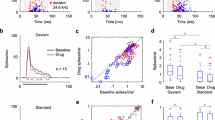Summary
-
1.
The amplitude-coding pyramidal neurons of the first-order nucleus in weakly electric gymnotiform fish (Eigenmannia), the electrosensory lateral line lobe (ELL), exhibit 2 major physiological transformations of primary afferent input. Pyramidal cells rapidly adapt to a step change in amplitude, and they have a center/surround receptive-field organization. This study examined the physiological role of GABAergic inhibition on pyramidal cells. GABAergic synapses onto the somata of pyramidal cells primarily originate from granule-cell interneurons along with descending input.
-
2.
Pyramidal cells fall into two physiologically distinct categories: E units, which are excited by a rise in stimulus amplitude, and I units, which are inhibited by a rise in stimulus amplitude. Microiontophoretic application of bicuculline methiodide onto both types of pyramidal cells increased the time constant of adaptation, defined as the time required for the neuron's response to decay to 37% of its maximum value, by 70–90%. The peak firing rate of E units to a step increase in stimulus amplitude increased by 49%, while the firing rate of I units did not change significantly.
-
3.
Bicuculline application demonstrated that GABAergic inhibition may contribute to the strict segregation of E and I response properties. In the presence of bicuculline, many E units (normally excited only by stimulus amplitude increases) became excited by both increases and decreases; many I units (normally excited only by amplitude decreases) also became excited to increases.
-
4.
The size of the excitatory receptive-field of E units was not affected by bicuculline, although response magnitude increased. The inhibitory surround increased in spatial extent by 175% with bicuculline administration. Neither the size of the I unit receptive-field center nor the response magnitude changed in the presence of bicuculline. The antagonistic surround of I units, however, increased by 49%.
-
5.
The anatomy of the ELL is well understood (see Carr and Maler 1986). The physiological results obtained in this study, along with the results of Bastian (1986a, b), further our understanding of the functional role of the ELL circuitry. Our results suggest that spatial and temporal response properties of pyramidal cells are regulated by different but interacting inhibitory interneurons, some of which use GABA as a neurotransmitter (see Figs. 11 and 12). The activity of these interneurons is in turn controlled by descending feedback systems.
Similar content being viewed by others
Abbreviations
- ELL :
-
electrosensory lateral line lobe
- EOD :
-
electric organ discharge
- NPd :
-
dorsal nucleus praeeminentialis
- EGP :
-
eminentia granularis posterior
References
Bastian J (1981) Electrolocation II. The effects of moving objects and other electrical stimuli on the activities of two categories of posterior lateral line lobe cells inApteronotus albifrons. J Comp Physiol 144:481–494
Bastian J (1985) Gain control in a primary sensory processing area, the electrosensory lateral line lobe, by means of descending input from the midbrain. Soc Neurosci Abstr 11:496
Bastian J (1986a) Gain control in the electrosensory system mediated by descending inputs to the electrosensory lateral line lobe. J Neurosci 6:553–562
Bastian J (1986b) Gain control in the electrosensory system: a role for the descending projections to the electrosensory lateral line lobe. J Comp Physiol A 158:505–515
Bastian J (1986c) Electrolocation:behavior, anatomy, and physiology. In: Bullock TH, Heiligenberg W (eds) Electroreception. Wiley, New York, pp 577–612
Batuev AS, Alexandrov AA, Scheynikov NA (1982) Picrotoxin action on the receptive fields of the cat sensorimotor cortex neurons. J Neurosci Res 7:49–55
Carr C, Maler L (1986) Electroreception in gymnotiform fish: central anatomy and physiology. In:Bullock TH, Heiligenberg W (eds) Electroreception. Wiley, New York, pp 319–373
Carr C, Maler L, Sas E (1982) Peripheral organization and central projections of the electrosensory nerves in gymnotiform fish. J Comp Neurol 211:139–153
DiDomenico R, Eaton RC (1988) Seven principles for command and the neural causation of behavior. Brain Behav Evol 31:125–140
Dye J (1987) Dynamics and stimulus-dependence of pacemaker control during behavioral modulations in the weakly electric fish,Apteronotus. J Comp Physiol A 161:175–185
Dykes RW, Landry P, Metherate R, Hicks TP (1984) Functional role of GABA in cat primary somatosensory cortex: shaping receptive fields of cortical neurons. J Neurophysiol 52:1066–1093
Eaton RC, DiDomenico (1985) Command and the neural causation of behavior: a theoretical analysis of the necessity and sufficiency paradigm. Brain Behav Evol 27:132–164
Enger PS, Szabo T (1965) Activity of central neurons involved in electroreception in some weakly electric fish (Gymnotidae). J Neurophysiol 28:800–818
Frank K, Becker MC (1964) Microelectrodes for recording and stimulation. In: Nastuk WL (ed) Physical techniques in biological research, vol 5, part A. Academic Press, New York, pp 23–84
Hagiwara S, Szabo T, Enger PS (1965) Electroreceptor mechanisms in a high-frequency electric fish,Sternarchus albifrons. J Neurophysiol 28:784–799
Harris FA, Towe AL (1976) Effects of topical bicuculline on primary evoked responses in pericruciate and precoronal cortex of the domestic cat. Exp Neurol 52:227–242
Heiligenberg W, Dye J (1982) Labelling of electroreceptive afferents in a gymnotoid fish by intracellular injection of HRP: the mystery of multiple maps. J Comp Physiol 148:287–296
Hicks TP (1983) Antagonism of synaptic transmission in vivo: contributions of microiontophoresis. Brain Behav Evol 22:1–12
Hicks TP, Dykes RW (1983) Receptive field size for certain neurons in primary somatosensory cortex is determined by GABA mediated intracortical inhibition. Brain Res 274:160–164
Hopkins CD (1976) Stimulus filtering and electroreception: tuberous electroreceptors in three species of gymnotoid fish. J Comp Physiol 111:171–202
Maler L (1979) The posterior lateral line lobe of certain gymnotoid fish: quantitative light microscopy. J Comp Neurol 183:323–364
Maler L, Mugnaini E (1986) Immunohistochemical identification of GABAergic synapses in the electrosensory lateral line lobe of a weakly electric fish (Apteronotus leptorhynchus). Soc Neurosci Abstr 12:312
Maler L, Sas E, Rogers J (1981a) The cytology of the posterior lateral line lobe of high frequency electric fish (Gymnotidae): dendritic differentiation and synaptic specificity in a simple cortex. J Comp Neurol 158:87–141
Maler L, Collins M, Mathieson WB (1981b) The distribution of acetylcholinesterase and choline acetyltransferase in the cerebellum and posterior lateral line lobe of weakly electric fish (Gymnotidae). Brain Res 226:320–325
Maler L, Sas E, Carr C, Matsubara J (1982) Efferent projections of the posterior lateral line lobe in gymnotiform fish. J Comp Neurol 211:154–164
Marr D (1982) Vision. Freeman Press, San Francisco
Mathieson WB, Maler L (1986) Ionic basis for repetitive firing of ELL pyramidal neurons in vitro. Soc Neurosci Abstr 12:312
Mathieson WB, Maler L (1988) Morphological and electrophysiological properties of a novel in vitro preparation: the electrosensory lateral line lobe brain slice. J Comp Physiol A 163:489–506
Mathieson WB, Heiligenberg W, Maler L (1987) Ultrastructural studies of physiologically identified electrosensory afferent synapses in the gymnotiform fish,Eigenmannia. J Comp Neurol 255:526–537
Nadi S, Maler L (1987) The laminar distribution of amino acids in the caudal cerebellum and electrosensory lateral line lobe of weakly electric fish (Gymnotidae). Brain Res 425:218–224
Partridge BL, Heiligenberg W, Matsubara J (1981) The neural basis of a sensory filter in the jamming avoidance response: no grandmother cells in sight. J Comp Physiol 145:153–168
Phan M, Maler L (1983) Distribution of muscarinic receptors in the caudal cerebellum and electrosensory lateral line lobe of gymnotiform fish. Neurosci Let 42:137–143
Sas E, Maler L (1983) The nucleus praeeminentialis: a Golgi study of a feedback center in the electrosensory system of gymnotid fish. J Comp Neurol 221:127–144
Saunders J, Bastian J (1984) The physiology and morphology of two types of electrosensory neurons in the weakly electric fishApteronotus leptorhynchus. J Comp Physiol A 154:199–209
Scheich H (1977) Neural basis of communication in the high frequency electric fish,Eigenmannia virescens (jamming avoidance response) III. Central integration in the sensory pathway and control of the pacemaker. J Comp Physiol 113:229–255
Scheich H, Bullock TH, Hamstra RH (1973) Coding properties of two categories of afferent nerve fibers: high frequency electroreceptors in the electric fish,Eigenmannia. J Neurophysiol 36:39–60
Shumway C (1984) Efferent connections of the electrosensory lateral line lobe: an intracellular HRP and Lucifer study. Soc Neurosci Abstr 10:403
Shumway C (1985) Pyramidal cells in the multiple electrosensory maps of the electrosensory lateral line lobe (ELLL) have a center-surround receptive field. Soc Neurosci Abstr 11:269
Shumway C, Maler L (1987) Bicuculline affects both temporal and receptive field properties of pyramidal cells in the electrosensory lateral line lobe. Soc Neurosci Abstr 13:622
Sillito AM (1979) Inhibitory mechanisms influencing complex cell orientation selectivity and their modification at high resting discharge levels. J Physiol 289:33–53
Sillito AM (1984) Functional considerations of the operation of GABAergic inhibitory processes in the visual cortex. In: Jones EG, Peters A (eds) Cerebral cortex, vol 2. Functional properties of cortical cells. Plenum Press, New York, pp 91–117
Tong SL (1982) The nucleus praeeminentialis: an electro- and mechanoreceptive center in the brainstem of the catfish. J Comp Physiol 145:299–309
Author information
Authors and Affiliations
Rights and permissions
About this article
Cite this article
Shumway, C.A., Maler, L. GABAergic inhibition shapes temporal and spatial response properties of pyramidal cells in the electrosensory lateral line lobe of gymnotiform fish. J. Comp. Physiol. 164, 391–407 (1989). https://doi.org/10.1007/BF00612998
Accepted:
Issue Date:
DOI: https://doi.org/10.1007/BF00612998




